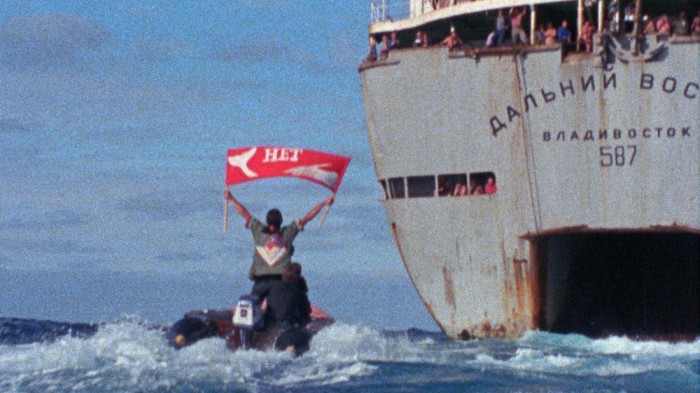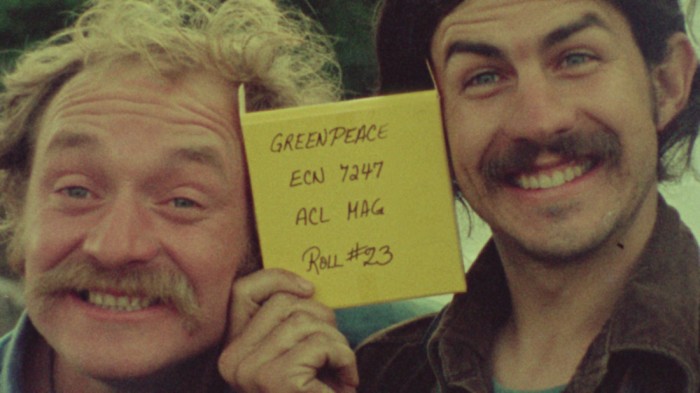'How To Change The World' Shows The Power Of Media-Savvy Activism [Sundance 2015 Review]
Being too young when the group was in its initial firebrand incarnation to understand, much less appreciate the early activism of Greenpeace, I've ended up simply dismissive of the organization as a whole. That's despite knowing nothing about the group's founding. The Sundance doc How to Change the World is a good way find a path back through the group's history.
At its best, How to Change the World is tremendously inspiring, and by turns thrilling, comic, and shocking. A portrait of the achievements of an unlikely group of allies rather than a sales pitch for the modern organization, How to Change the World is drawn from writings by founder Robert Hunter, the group's shaggy, media-savvy general, and features jaw-dropping footage culled from the Greenpeace archive of film footage. Though while the film offers a vision of Greenpeace I'd never seen, it is also somewhat overlong, and cursed with organizational problems that add nothing to the audience experience.
A Ragged Crew
The origin of the now-global institution is in fact the story of a ragged group of Vancouver-based idealists who banded together to protest an underground nuclear test in Alaska. Revolving around Rob Hunter, who acted as the group's unwitting nucleus, the story of Greenpeace features a mushroom enthusiast named Walrus; a real-world version of Quint from Jaws; and a paired set of opposites whose personal and idealogical conflicts would ultimately damage the group almost beyond repair.
The film is "narrated" by Hunter, who passed away in 2005. As in the Roger Ebert doc Life Itself, the subject is voiced by an actor — Barry Pepper, doing a terrific job — reading passages from Hunter's own writings. Between Hunter's words and the plentiful film footage captured by Greenpeace members, the film has a unique and compelling voice. There's a bit of "poetic hippie" in there, especially when a mind-expanding drug trip episode is accompanied by animated shapes and Pink Floyd's 'Breathe,' but there's a lot of honesty and wisdom, too.
 Bearing Witness
Bearing Witness
The concept behind Greenpeace at the time was to "bear witness" in the Quaker sense — in effect, hoping to change behavior by observing it. And it worked, thanks both to the group's media-savvy approach, and to the raw impact of the imagery captured in campaigns to investigate industrialized Russian whalers and baby seal-clubbing hunters. Their courage in the face of resistance from these industries, as captured in unvarnished footage, is grim and impressive.
The doc loosely follows that concept of bearing witness by showing us that footage. New interviews with many participants explain how pressures drove the group, and ultimately pushed wedges between the core members. Ultimately there's perhaps too much witness to bear, as the film threatens to collapse under the weight and number of its own voices. A tighter edit might remove a few colorful personalities (like the synthesizer player brought on a voyage to maybe, I guess, musically "talk" to whales — the concept is introduced, then dropped) but could enhance the film's most important ideas.
 Disorganizational Principles
Disorganizational Principles
Though the earlier Greenpeace campaigns faced legal and beaurocratic trouble, and resistance from hunters on both an industrial and local level, the real threats to the group were its own loose organization and inability to evolve as its profile grew. How does a once-small group maintain energy, ideals and effectiveness as hordes of loosely-affiliated chapters emerge across the globe, with no organizational principle guiding them all? In short: barely, and the film spends a lot of time on the problem, nearly losing sight of the personalities involved in the process.
The damage done by a lack of organization is ironically mirrored by the film, which makes a couple of big mistakes. One is giving too much time to ultimately tangental voices, and the other is a chapter structure, presumably sorted from Hunter's writings, which uses "rules" to offer a blueprint to effect change. (Rule examples: "fear success" and "plant a mind bomb.") These rules are articulated in the film quite well, but the reason for breaking the doc down into numbered chapters is never quite clear. There's no great aggregate takeaway from using this setup, and the already dense and lengthy doc is made to feel even longer by the imposition of the chapter structure.
Visions of Brutality
This review comes with a warning: severely brutal sights lurk within. Greenpeace bore witness to practices that had rarely been documented for the public, and the footage the group captured helped form public opinion on industrialized whaling and baby seal clubbing. The raw footage from activist cameras shows hooks peeling away house-sized sheets of whale skin in one tug; a geyser of blood blowing out the side of a whaling ship; and the faces of bludgeoned and skinned seals.
The images are not for the faint of heart, but they are also part of the point — to fully understand the early effect of Greenpeace we have to see what they saw. We've got to see those whales being brutalized to understand why Rob Hunter tried to put himself between the whaler's harpoon and targeted whales, and to realize the power of the images that made the world take notice. The problems faced by the group pale in comparison to that power.
/Film Rating: 7 out of 10
